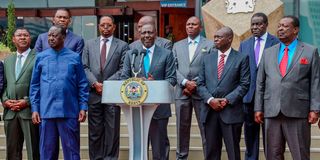
President William Ruto addresses journalists at KICC, Nairobi flanked by his deputy Rigathi Gachagua, Azimio leader Raila Odinga and other national leaders on July 9, 2024.
Certainly, if Kenya’s power elite had built a robust opposition, the Gen Z revolt would not have come to our streets. For long, a feeble and increasingly dysfunctional opposition, now seemingly headed to its deathbed, has been the weakest link in Kenya’s nascent democracy.
President William Ruto is courting the idea of ‘Unity Government’ as an easy answer to the fury of the anti-tax revolutionaries. On July 19, 2024, the President unveiled 11 Cabinet Secretary nominees to replace the 22 members of cabinet he had fired on July 11. This has set the stage for a ‘broad-based’ cabinet in a power-sharing deal with the opposition.
Ruto’s foray into elite power-sharing as a magic bullet to the Gen-Z challenge carries eerie echoes from President Mwai Kibaki’s ‘Grand Coalition Government’ and a power-sharing Cabinet as a response to the 2008 post-election impasse. The result was that the opposition was nearly obliterated.
Elite power-sharing is a crude solution to Kenya’s complex problem of building an inclusive, merit-based nation with value-based leadership. This is the first in a series of articles on elite power-sharing as a poisoned chalice for Kenya’s opposition.
For starters, a robust opposition is at the heart of Kenya’s governance. The architects of Kenya’s 2010 Constitution adopted the concept of two governments as the cornerstone of the country’s governance system. On the one end is the ‘Government-in-power’, popularly known as the Executive — comprising of the President, the Deputy President and the Cabinet. The ‘Government-in-power’ appoints the occupants of all positions created by the constitution according to the law.
On the other end is the ‘Government-in-Waiting’, famously known as the opposition, in Kenya is weak, underdeveloped and largely dysfunctional.
Majority leader
The concept of two governments side by side comes alive in the legislative arm of Kenya’s government. In Parliament, the ‘Government in Power’ is led by the “leader of the majority party” as the leader of the largest party or coalition of parties” (108:2). By the same token, the ‘Government-in-Waiting’ is led by the “leader of the minority party” as the leader of second largest party or coalition of parties (108: 3). The hierarchy of power in Parliament puts the two governments under the Speaker (108: 4:(a). Below the speaker is the majority leader followed by the minority leader (108:4(b, c)).
In both Senate and National Assembly, power is shared according to this order and also in recognition. But it is recognized that the minority side must have its day because of its sacred responsibility to keep the executive side under check. Admittedly, the majority in parliament are an extension of the ruling party and the executive.
But the Achilles heel of Kenya’s pure presidential system is the “national executive of the Republic”, which is created by the winner-takes-all principle that underpins Kenya’s election system. Kenya has come a long way since the time of the parliamentary and semi-presidential systems of the past when the Vice-President was appointed by an “imperial President.”
Today, the country has an integrated Presidency made up of the President and the Deputy President, both joined at the hip, almost literally. Normally, the two would work together to appoint the Cabinet and other key office bearers. But in view of Kenya’s ethnically diverse — and often divided — society, the composition of the executive is part of the process of managing diversity to ensure “the face of Kenya” and stabilize the polity. In this regard, our law is clear: “The composition of the national executive shall reflect the regional and ethnic diversity of the people of Kenya” (130:2).
While safeguarding regional and ethnic balance, our law is markedly mute on meritocracy — the cornerstone of our society and democracy. The downside of this, as our recent collective experience has taught us, is that the executive is almost the only arm of our government which can be packed with halfwits and simpletons as a reward for their “warrior” role in the election of the president and his deputy to power. As the on-going debate on cabinet appointees shows, creating the national executive is a delicate balancing act between “regional and ethnic” factors and meritocracy.
Dominant power elite
Power-sharing is about the interests of the dominant power elite. The idea is a throwback to elite power-play of the past. Manifestly, over the years the doyens of Luo politics (Jaramogi Oginga Odinga and his heir, Raila Odinga) have perfected the art and craft of getting the winners of presidential elections to share executive power.
The Odingas honed the art of power sharing during the 1992-2002 decade when the Kalenjin (under Daniel Moi) controlled the executive and the Kikuyu — under Kenneth Matiba (1992-1997) and Kibaki (1997-2002) were at the helm of the opposition. Power-sharing has enabled the Luo elite to remain relevant in politics even though coming from the bottom end of the big five: the Kikuyu (17.1%), Luhya (14.3%), Kalenjin (13.4%), Luo (10.7%), Kamba (9.8%).
Moi agreed to power-sharing with the Odinga in order to get their support in parliament. In the 1992-1994 hiatus, Senior Odinga maintained a largely informal power-sharing arrangement with Moi. And in the 1997-2002 period, Raila merged his NDP with KANU, paving the way for the inclusion of his allies into the Moi cabinet.
Moreover, in the 2002-2005 hiatus, when the Kikuyu headed both the executive (Mwai Kibaki) and the opposition (Uhuru Kenyatta), Raila joined the executive, but was very unhappy as number three in the hierarchy of power in Kibaki’s “rainbow coalition.”
Raila rose to the helm of the opposition after the 2005 referendum when Kibaki, who lost the vote, fired him from the cabinet. He formed the Orange Democratic Movement (ODM), becoming the supreme leader of the Opposition. Uhuru Kenyatta and KANU joined Kibaki’s PNU coalition in 2007.
Although Raila lost the 2007 presidential contest to Kibaki, he joined the Grand Coalition Government — famously “Nusu Mkate” — becoming Prime Minister, “co-principal” and “King in waiting” in the run up to the 2013 elections. He had become the grandmaster in the art of power-sharing.
Professor Peter Kagwanja is former Government Adviser and chief executive at the Africa Policy Institute










